
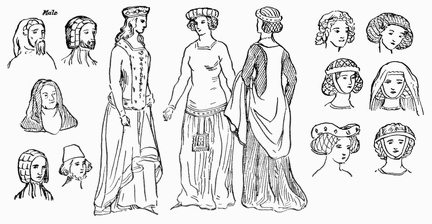 Fourteenth century, 2nd half
Fourteenth century, 2nd half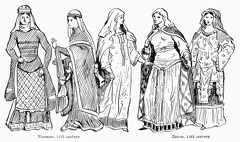 Norman and Saxon Costume - 12th Century
Norman and Saxon Costume - 12th Century Twelfth to fourteenth century
Twelfth to fourteenth century Tenth to thirteenth century
Tenth to thirteenth century Types of Shoes - British, Roman, Norman to 13th century
Types of Shoes - British, Roman, Norman to 13th century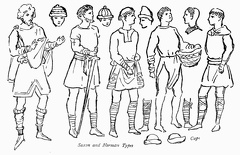 Caps - Saxon and Norman types
Caps - Saxon and Norman types Civil Costume about 1620
Civil Costume about 1620 A Countryman and Countrywoman
A Countryman and Countrywoman Costume of a Lawyer
Costume of a Lawyer A Citizen and his wife
A Citizen and his wife A Gentleman and gentlewoman
A Gentleman and gentlewoman Ordinary Dress of Gentlemen in 1675
Ordinary Dress of Gentlemen in 1675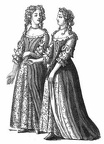 Dress of Ladies of Quality
Dress of Ladies of Quality Ordinary Attire of Women of the Lower Classes
Ordinary Attire of Women of the Lower Classes Costume of Shepherds in the Twelfth Century
Costume of Shepherds in the Twelfth Century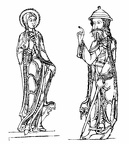 Lay Costumes in the Twelfth Century
Lay Costumes in the Twelfth Century Ecclesiastical Costume in the Twelfth Century
Ecclesiastical Costume in the Twelfth Century A Gallo-Roman
A Gallo-Roman A Gallo-Roman Woman
A Gallo-Roman Woman Leathern Apron
Leathern Apron Apron
Apron Brass to a merchant
Brass to a merchant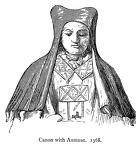 Canon with Aumuse
Canon with Aumuse Aumuse
Aumuse Albe
Albe The reformed dress
The reformed dress A servant with tucked sleeves
A servant with tucked sleeves The obi for ordinary wear. For girls. For women
The obi for ordinary wear. For girls. For women The hakama
The hakama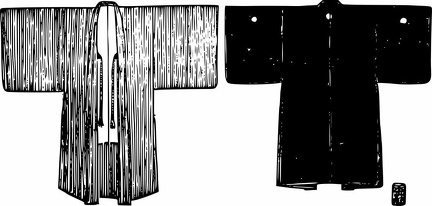 The haori
The haori The obi, square and plain
The obi, square and plain The kimono, rear and front view
The kimono, rear and front view A young lady dressed for a visit
A young lady dressed for a visit Later Costume of Ethiopian Nobles
Later Costume of Ethiopian Nobles Ethiopian Noble Lady
Ethiopian Noble Lady Sewn Sleeveless Kalasiris
Sewn Sleeveless Kalasiris Egyptian king
Egyptian king Egyptian Queen
Egyptian Queen Egyptian Female Costume
Egyptian Female Costume Young Gentleman Louis XIII period - 1625 - 1640
Young Gentleman Louis XIII period - 1625 - 1640 Women's Costume during the Directory - 1795 - 1800
Women's Costume during the Directory - 1795 - 1800 Tie-back skirt
Tie-back skirt The more practical gown of the Empire Period
The more practical gown of the Empire Period The Incroyable of the Revolution Period - 1795
The Incroyable of the Revolution Period - 1795 The Grecian Bend
The Grecian Bend The Extreme of the Crinoline - 1862
The Extreme of the Crinoline - 1862 The 1840 style
The 1840 style The 1830 Effect
The 1830 Effect Street costume Late Louis XVI period - 1790
Street costume Late Louis XVI period - 1790 Reversion to the classic (Grecian) type
Reversion to the classic (Grecian) type Mousquetaire or Cavalier Costume 1620 - 1640
Mousquetaire or Cavalier Costume 1620 - 1640 Morning costume of Dandy of the early Revolutionary period - 1791
Morning costume of Dandy of the early Revolutionary period - 1791 Middle class costume during French Revolution - showing Charlotte Corday cap
Middle class costume during French Revolution - showing Charlotte Corday cap Marie Antoinette style - Late Louis XVI period - 1790
Marie Antoinette style - Late Louis XVI period - 1790 Men's street costume Late Revolution and early Empire
Men's street costume Late Revolution and early Empire Louis XV
Louis XV Louis XIV Period - about 1700
Louis XIV Period - about 1700 Louis XIV Period - about 1670
Louis XIV Period - about 1670 Louis XIII - about 1640
Louis XIII - about 1640 Later Louis XIV Period 1700 - 1715
Later Louis XIV Period 1700 - 1715



